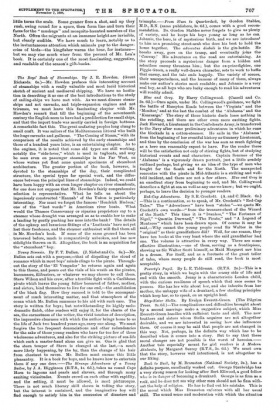The Boys' Book of Steamships. By J. R. }Lowden. (Grant
Richards. 6s.)—Mr. Howden prefaces this interesting account of steamships with a really valuable and most lucid historical sketch of ancient and mediaeval shipping. We have no hesita- tion in describing it as one. of the best introductions to the study of sailing-ships we have met with. As we must discuss steam- ships and not carracks, and triple-expansion engines and not triremes, we must leave this fascinating chapter with Mr. Howden's remark that till the beginning of the seventeenth century the English seem to have had a predilection for small ships, and that the import trade was mostly carried in foreign bottoms. A remarkable fact this. The great seafaring peoples long clung to small craft. It was sailors of the Mediterranean littoral who built the huge carracks and galleons. " The Coming of Steam," with its comparison of the results achieved by the early steamships and those of a hundred years later, is an entertaining chapter. As to the engines, it is noted that some old types are still working, notably the "side-lever," which is used in tugboats, and may be seen even on passenger steamships in the Far West, on whose waters yet float some quaint specimens of steamboat architecture. The greater portion of the book, however, is devoted to the steamships of the day, their complicated structure, the special types for special work, and the differ- ences between the principal lines of steamships. Indeed, we could have been happy with an even longer chapter on river steamboats, for one does not suppose that Mr. Howden's fairly comprehensive selection is representative. What he tells us about the ingeniously constructed ' Hannah' of the Yukon is particularly interesting. Nor must we forget the famous 'Hendrick Hudson,' one of the "last words" in American river boats. What would the Thames Conservancy or riparian proprietors say to a steamer whose draught was arranged so as to enable her to make a landing by gently pushing her nose into the bank ? The details of the upkeep and luxurious fittings of a Lusitania ' have not yet lost their freshness, and the steamer enthusiast will find them all in Mr. Howden's book. If some of the same ground has been traversed before, much is comparatively unbroken, and has new sidelights thrown on it. Altogether, the book is an acquisition for the " steamboat" boy.




























































 Previous page
Previous page